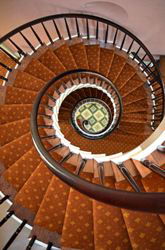
Indiana Landmarks, a private nonprofit organization that saves historic places, will present the award to the home’s owner, Historic Madison, Inc., at its annual Rescue Party on April 27 in Indianapolis.
Located at 301 W. First St. in Madison’s National Historic Landmark district, the Shrewsbury-Windle House is considered by many experts to be the finest example of Greek Revival domestic interior design in the United States. The home features floor-to-ceiling windows with views of the Ohio River, and a spiral staircase ascending through the center of the home – an engineering marvel in itself. Charles Shrewsbury, who had the home built, entertained frequently, often hosting celebrities and dignitaries who were visiting Madison.
The Shrewsbury-Windle House’s legacy as a venue for gatherings inspired the preservation organization Historic Madison, Inc., to turn it into an event venue beginning in 2011. It had been a private residence prior to its transformation.
John and Ann Windle, who bought the home in 1948, were a driving force for historic preservation, founding Historic Madison in their home in 1960 and convincing locals and visitors that the city’s architecture was its key economic asset. Upon Ann’s death in 2009, Historic Madison inherited the home, which is designated a National Historic Landmark, the highest historic designation a building can attain in the U.S.
The house retained many of its original, character-defining features, including the stunning spiral staircase and original gasoliers—even paint from the 1850s on the drawing room walls. However, a leaky roof and deferred maintenance had taken a toll. Only a portion of the house was heated, and air conditioning had never seen installed—factors that limited the property’s public use.
Historic Madison raised $2.2 million for the Shrewsbury-Windle House restoration, which included repairing the roof and chimneys, updating the 1920s and 1950s mechanical, electric, and plumbing systems, and installing air conditioning, additional restrooms, and a sympathetic ramp to make the first floor accessible.
Engineers faced a bigger challenge in figuring out how to add modern mechanical and lighting systems without marring the home’s historic appearance. Heating and cooling units went into the basement and attic, with lines running through the back of closets and a non-working chimney. Electricians restored the original gas light fixtures, now fitted with LED lamps and an electronic control system since the home has no light switches.
“With this project, Historic Madison demonstrates the highest standards of restoration,” says Indiana Landmarks President Marsh Davis. “And as a venue for community programs and events, the Shrewsbury-Windle House has taken on a new relevance beyond its iconic status as one of our nation’s most revered Greek Revival buildings.”
“What better way to honor the Shrewsburys and Windles than by continuing their tradition of making the home a gathering place and doing as good a restoration as possible?” said Historic Madison President and Executive Director John Staicer. “The reaction to the restoration has been overwhelming and quite moving.”
Renowned for its street upon street of mid-nineteenth-century homes and commercial buildings, Madison boasts one of the largest National Historic Landmark districts in the nation.
Indiana Landmarks



